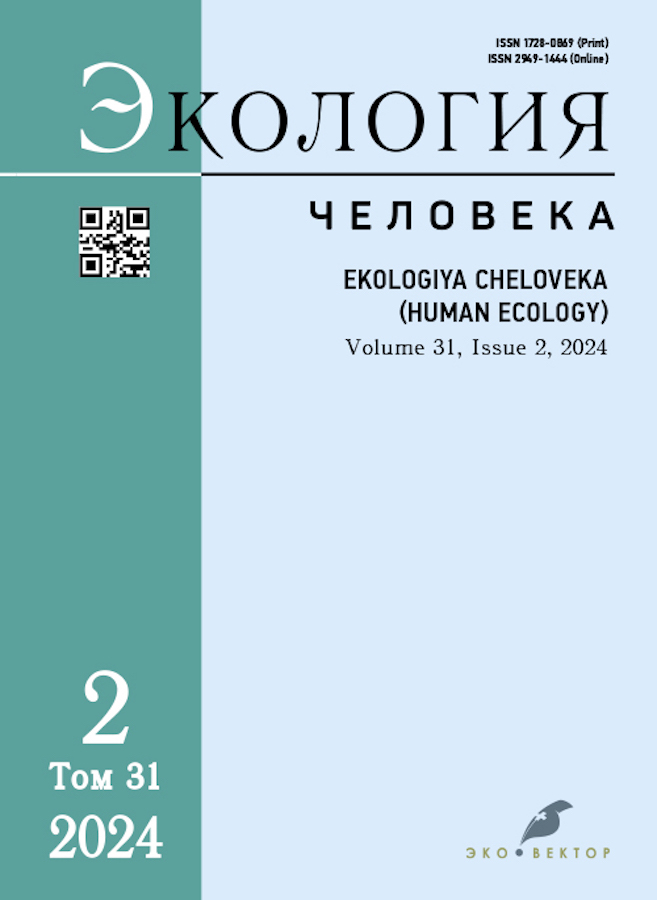心率调节对屏气功能测试的适应性反应
- 作者: Deryagina L.E.1, Bulatetsky S.V.2
-
隶属关系:
- Moscow University of the Ministry of Internal Affairs of the Russian Federation named after V.Y. Kikot
- Ryazan State Medical University named after academician I.P. Pavlov
- 期: 卷 31, 编号 2 (2024)
- 页面: 135-147
- 栏目: ORIGINAL STUDY ARTICLES
- URL: https://journal-vniispk.ru/1728-0869/article/view/314515
- DOI: https://doi.org/10.17816/humeco630114
- ID: 314515
如何引用文章
全文:
详细
理由 从适应理论的角度来看,研究人员对生物体内生物节律的同步性特别感兴趣。
研究目的 揭示在吸气和呼气时任意屏气的测试中心律调节影响的特殊反应。
材料和方法 随机选取 21 名学生作为研究对象,年龄(20.64±1.14)岁,体重(67.19±12.98)公斤,身高(172.29±7.63)厘米,其中男性 9 名,女性 12 名。按照 N.I. Shlyk(2009 年)的分类法,根据心律调节中枢回路或自主回路的主导地位,将所有受试者分为 3 组(I、II、III)。休息五分钟后,在坐姿下使用硬件-软件复合机 “Varicard 3.0 ”进行五次连续心电图登记:1-初始状态;2-吸气时自主屏气;3-静息状态;4-呼气时自主屏气;5-静息状态。心律的数学分析使用硬件和软件复合体 “Varicard 3.0 ”进行;分析中考虑了心律的统计参数和频谱频率分析参数。
分析结果 在对数据进行分析时,我们发现在憋气期间,各组的心律变异性都有所下降,而在静息状态下,心律变异性都有所上升。与此同时,根据频谱分析数据(HF=LF),第一组在憋气测试后的静息状态下出现了痰。该组的统计和时间分析数据表明,副交感神经成分对心率变异性(RMSSD、pNN50、SDNN、CV)的贡献增加,为其放大创造了先决条件。第二组在屏气测试后,交感神经活动略有下降。同时,在憋气呼气试验中观察到自律神经调节紧张的模式,这可能表明调节系统的功能状态有所减弱。第三组的特点是在憋气测试中交感神经活动急剧增加,随后在憋气测试中得到轻微纠正,这可被视为机体对负荷的充分反应。测试结束后休息时,调节模式又恢复到最初的模式,副交感神经活动适度占优势,相应地,机体的心率变异性水平也更高。
结论 心率变异性的适应性反应表现为交感神经激活的增加,随后在正常呼吸过程中被自律神经系统副交感神经部分的补偿性纳入所取代。尽管心率变异性具有单向性,但反应的表现形式因所接受的等级组别而异。
作者简介
Larisa E. Deryagina
Moscow University of the Ministry of Internal Affairs of the Russian Federation named after V.Y. Kikot
Email: lderyagina@mail.ru
ORCID iD: 0000-0001-5522-5950
SPIN 代码: 6606-6628
MD, Dr. Sci. (Medicine), Professor
俄罗斯联邦, MoscowSergey V. Bulatetsky
Ryazan State Medical University named after academician I.P. Pavlov
编辑信件的主要联系方式.
Email: dr_bsv@mail.ru
ORCID iD: 0000-0002-6023-7523
SPIN 代码: 2756-9179
Sergey V. Bulatetsky
俄罗斯联邦, Ryazan参考
- Zenchenko TA, Jordanova M, Poskotinova LV, et al. Synchronization between human heart rate dynamics and Pc5 geomagnetic pulsations at different latitudes. Biofizika. 2014;59(6):1186–1194. EDN: TGWDJZ
- Pokrovskii VM, Polishchuk SV, Gorbunov RV, Gurskaya EV. Cardio-respiratory synchronism: new methodological and methodological possibilities for assessing the level of adaptationю In: Physiological problems of adaptation: Collection of scientific papers articles. Stavropol; 2008. P. 141–143. (In Russ.)
- Odegov AK, Bulatetsky SV, Prisakaru MN. Controlled breathing as a way to correct the functional state of the human body through the management of HRV. In: Physiology — actual problems of fundamental and applied research: materials of the All-Russian scientific and practical conference with international participation dedicated to the 125th anniversary of the birth of Academician Pyotr Kuzmich Anokhin. Volgograd; 2023. P. 268–271. EDN: QZFWBY (In Russ.)
- Shlyk NI. Heart rate and regulation type of children, teenagers and sportsmen. Izhevsk: Udmurtskii universitet; 2009. EDN: QLVYBB (In Russ.)
- Gridin LA. Modern understanding of the physiological and therapeutic and prophylactic effects of actions hypoxia and hypercapnia. Medicine. 2016;4(3):45–68. EDN: WMFKHN
- Tabarov MS. Features of the reactions of organ arteries and veins to humoral stimuli with the combined effect of hypoxia and hypothermia on the body [dissertation abstract]. Saint-Petersburg; 2003. 45 p. (In Russ.)
- Chizhov AYa, Potievskaya VI. The normalizing effect of normobaric hypoxic hypoxia. Fiziologiya Cheloveka. 1997;23(1):108–112. (In Russ.)
- Chub IS, Milkova AV, Eliseeva NS. The condition of cardiorespiratory system in students with different degree of resistance to hypoxia. Bulletin Physiology and Pathology of Respiration. 2014;(52):8–15. EDN: SFMHZR
- Agadzhanyan NA, Polunin IN, Stepanov VK, Polyakov VN. A person in conditions of hypocapnia and hypercapnia. Astrakhan: AGMA; 2001. (In Russ.)
- Nenasheva AV, Aminov AS, Pozina NV, et al. Hypoxia resistance and vestibular stability of pupils and pupils aged 6-14 years of the social rehabilitation center. Vestnik Yuzhno-Uralskogo gosudarstvennogo universiteta. Seriya: Obrazovanie, zdravookhranenie, fizicheskaya kultura. 2007;(2):120–124. EDN: KWYCOH (In Russ.)
- Divert VE, Krivoshchekov SG, Vodyanitsky SN. Individual-typological assessment of cardiorespiratory responses to hypoxia and hypercapnia in young healthy men. Fiziologiya Cheloveka. 2015;41(2):64–73. EDN: TLOUMD doi: 10.7868/S0131164615020058
- Agadzhanyan NA, Dvoenosov VG. Physiological features of the combined effect of acute hypoxia and hypercapnia on the body. Bulletin of Rehabilitation Medicine. 2008;(1):4–8. EDN: MUOCKB (In Russ.)
- Divert VE, Komlyagina TG, Krasnikova NV, et al. Cardiorespiratory responses of swimmers to hypoxia and hypercapnia. Novosibirsk State Pedagogical University Bulletin. 2017;7(5):207–224. EDN: ZQXRWL doi: 10.15293/2226-3365.1705.14
- Mikhailova AV. Features of heart rate variability indicators in athletes with overstrain of the cardiovascular system. Russian Journal of Cardiology. 2020;25(S2):34. EDN: KXMMYO (In Russ.)
- Shakhanova AV, Koblev YaK, Grechishkina SS. Features of adaptation of the cardiovascular system of athletes of different sports according to heart rate variability. The Bulletin of Adyghe State University. Seriya: Natural, Mathematical and Technical Sciences. 2010;(1):105–111. EDN: MUBOCP
- Shlyk NI. Management of athletic training taking into account individual heart rate variability characteristics. Fiziologiya Cheloveka. 2016;42(6):81–91. EDN: XGWDHD doi: 10.7868/S0131164616060187
- Davila MI, Lewis GF, Porges SW. PhysioCam: a new non-contact sensor for measuring heart rate variability in clinical and field settings. Public Health Front. 2017;5:300. doi: 10.3389/fpubh.2017.00300
- Hayano J, Yuda E. Pitfalls of assessing autonomic function using heart rate variability. J Physiol Anthropol. 2019;38(1):3. doi: 10.1186/s40101-019-0193-2
- Bykov EV, Balberova OV, Sabiryanova ES, Chipyshev AV. The features of myocardial hemodynamic and vegetative homeostasis in athletes of different qualifications from acyclic sports. Human. Sport. Medicine. 2019;19(3):36–45. EDN: OZGERY doi: 10.14529/hsm190305
- Schneider M, Schwerdtfeger A. Autonomic dysfunction in posttraumatic stress disorder indexed by heart rate variability: a meta-analysis. Psychol Med. 2020;50(12):1937–1948. doi: 10.1017/S003329172000207X
- McCraty R, Schaffer F. Heart rate variability: new insights into physiological mechanisms, assessment of self-regulatory capacity, and health risk. Global Advances in Health and Medicine. 2015;4(1):46–61. doi: 10.7453/gahmj.2014.073
- Zaccaro A, Piarulli A, Laurino M, et al. How breath-control can change your life: a systematic review on psycho-physiological correlates of slow breathing. Front Hum Neurosci. 2018;12:353. doi: 10.3389/fnhum.2018.00353
- Malhotra V, Bharshankar R, Ravi N, Bhagat OL. Acute effects on heart rate variability during slow deep breathing. Mymensingh Med J. 2021;30(1):208–213.
补充文件







